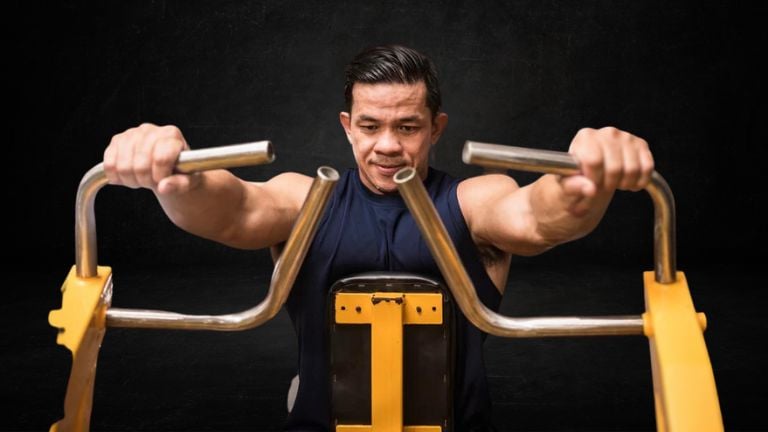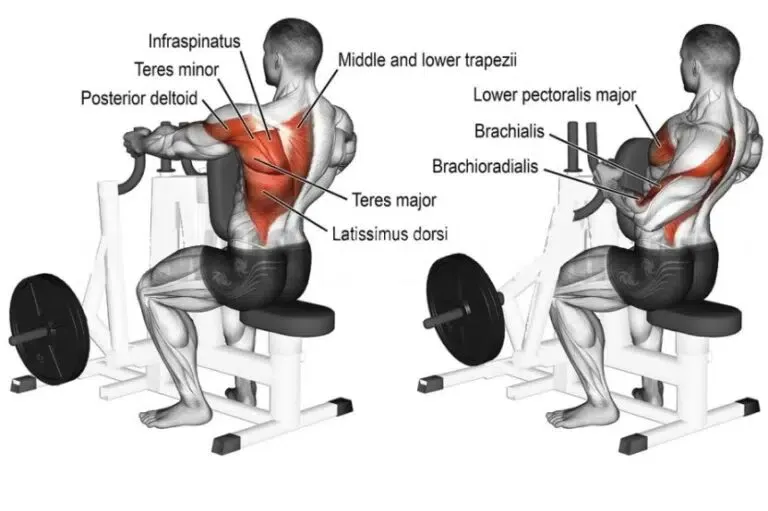The Seated machine back row, also known as the chest-supported row, is a strength training exercise that primarily targets the muscles of the upper and middle back.
I have found the Seated machine back row to be one of the most reliable exercises for precisely targeting your back muscles.
If you’re like me, you may find free weights a bit unstable, especially when focusing on form. Since they minimize the strain on your lower back and allow you to focus on what matters: building strength and muscle definition in your back.
It usually consists of a padded chest support, a seat, and handlebars or grips connected to a weight stack or plates. Many machines allow seated machine rows with an underhand, overhand, neutral, close, or wide grip.
I like to do it with a neutral grip, and during my last few sets, I have done it with a single arm. Try it, and you’ll see the difference in muscle activation.
Want to take your gains to the next level? Discover your daily calorie needs with our free TDEE calculator.

Seated Machine Back Row Muscles Worked
The seated machine row is an excellent exercise for strengthening the back muscles.
- Primary Muscles: Latissimus dorsi (lats), Rhomboids and Trapezius (middle and lower fibers)
- Secondary Muscles: Posterior Deltoid, teres major, biceps brachii and brachialis.
- Stabilizing Muscles: Erector spinae, forearms, Rotator cuff muscles (infraspinatus, teres minor) and Core muscles

How To Do Seated Machine Row
- First, ensure that the seat and chest pad are about chest height when sitting down.
- Sit down, plant your feet firmly on the platform, and grab the handles with an overhand or neutral grip.
- Most row machines offer many grip options like wide grip or neutral grip. Choose the one you like.
- Sit up straight with a neutral spine. Your chest should be pressed lightly against the chest pad.
- Your head should be aligned with your spine – neither looking too far up nor down.
- Engage your core. Imagine drawing your navel toward your spine to ensure your core remains tight.
- Pull the handle back towards you. As you pull, focus on squeezing your shoulder blades together.
- Continue pulling the handles toward your torso until your elbows are just past your body.
- At the peak of the contraction, your back muscles should be fully engaged.
- Slowly release the handles forward in a controlled manner. Do not let the weight stack crash down. Maintain a constant resistance throughout the entire range of motion.
Tips and Form
- I’ve learned to always keep my chest firmly against the pad. This prevents me from using momentum or my lower back to pull the weight.
- Instead of thinking about pulling the handles, think about driving your elbows back. This simple mental shift helps you engage your lats, traps, and rhomboids more effectively.
- Maintain a neutral spine throughout the movement. Avoid rounding your back or arching your lower back excessively.
- Pay attention to your grip. I used to think that a simple grip was enough, but I’ve found that a neutral grip can be incredibly effective. It helps you move more naturally and effectively works the back muscles.
- When you pull the handles in, squeeze your shoulder blades together for a second or two. You’ll really feel the muscles engage, and this extra contraction helps with muscle growth.
- Don’t hesitate to use weight-lifting straps if your grip becomes limiting.
- It is possible to perform this exercise one arm after the other unilaterally, but be careful to maintain a straight posture and not to rotate your torso excessively.

Seated Machine Row Variations and Progression
The seated machine row can be changed up to keep workouts fresh, target muscles differently, and allow for continued growth and strength gains.
1. Changing Grip
- Overhand Grip (Pronated): With palms facing down, this grip emphasizes the upper lats and rear deltoids a bit more.
- Underhand Grip (Supinated): With palms facing up, this grip shifts the focus slightly more toward the lower lats and engages the biceps more intensely.
- Wide vs. Narrow Grip: Different handle attachments or hand spacings can emphasize various parts of the back. A wider grip targets the outer lats more, while a narrower grip focuses on the mid-back.
2. Single-Arm Rows for Unilateral Training
The row can be done one arm at a time to address muscle imbalances and ensure one side isn’t compensating for the other.
Single-arm machine rows often allow a deeper pull, further engaging the targeted muscles.
3. Progressively Overload
Gradually increasing the weight over time ensures that your muscles consistently adapt, grow, and gain strength. However, always prioritize form over weight.
4. Add Drop Sets
After completing a set at a heavier weight, immediately reduce the weight and perform another set. This method intensifies the workout and induces greater muscle fatigue.
5. Superset Sets
Pair the seated row with another back exercise, such as a lat pulldown, and perform them back-to-back with minimal rest in between.

Manish is a NASM-certified fitness and nutrition coach with over 10 years of experience in weight lifting and fat loss fitness coaching. He specializes in gym-based training and has a lot of knowledge about exercise, lifting technique, biomechanics, and more.
Through “Fit Life Regime,” he generously shares the insights he’s gained over a decade in the field. His goal is to equip others with the knowledge to start their own fitness journey.
